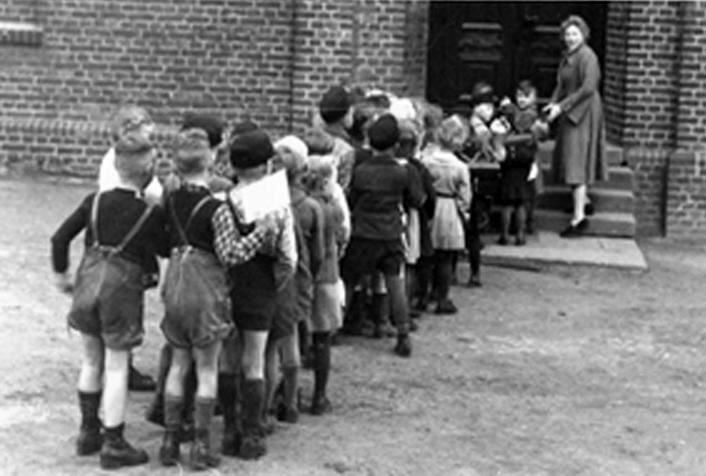
German Going and Coming to School: The School Yard in the Morning

Figure 1.--Here we see a class at Grundschule Kalthof (north Rhine region in Westphalia) in 1948. A Grundschule as far as we know was just abnother name for Volksschule--the first 4 years of school. The children (we assume a class group as they are all abouty the sane age) have been lined up in the school yard and the teacher is brining them into the school. Presumably there were other classes. What we are a little unsure about is only a few children have their book satchels. We wonder if some of the children arrived early and already put their satchels in the classroom. We note the usual school clothes at the time--short pants for the boys with a mixture of either knee socks or long stockings. They look to be about 7-8 years old. Notice the Lederhosen some of the boys are wearing. Also while we see Schirmmutze on some of the boys, none wer the traditionl German school caps.
|
|
Most German schools had school yards of some sort. I don't think there was much in the way of playground equipment, at least until after World War II. This was common throughout Europe. We are not entirly sure what happened at the school yard when the children got to school. We know that many children played there before school began. We do not know if the children were allowed into the classrooms if they arrived early. At some schools the teachers lined them up by class. We are not sure how common thisd was. Perhaps they sang the national athemn and then marched in into their classrooms. In America, we were allowed to play inthe school yard or go into our classrooms. We are not entirely sure what the procedure was in Germany. Of course it may have varied over time and from school to school. Given the dramatic shifts in governments during the 19th and 20th centuries, there almost certainly were major changes on this and manhy other school matters. And the type of school was anotyher factor. And there could have been differences on cold or rainy days. For some reason we have not found many photographs taken in the school yard.
Imperial Germany (1871-1918)
Weimar Republic (1918-33)
NAZI Era (1933-45)
A German reader writes, "I was born in 1935 and began primary school in 1941. I went to school in different places, different places, Stuttgart, Tuttlingen, and back to Wasseralfingen. I never had to use public transport to come to school, so I usually timed it to arrive just in time for class. Schools certainly were closed during night; I never was so early at school that it was still closed. I can`t remember if there were flag ceremonies outside every day. There probably was something on Hitler's birthday and other specil days. I can't remember much of primary school, just going to the class room. I can't remember singing NAZI songs in the morning when I came to school. Teachers were not trained in singing; and probably the Nazis feared that the children would only cry. There were music hours (one a week or so) with another teacher who had some education in conducting, and there also the Nazi songs were taught accompanied by playing the music at the piano by him, yes. There was no flag in the class room. We did stand up when the teacher arrived, may be -I can`t remember - to cry "Heil Hitler" in some classes and some teachers. We then sat down and school started. from Christmas 1944 until October 1945 I did not attend a school. This was because of the disruptions related to the bombing and than the collpapse of the NAZI Government."
West Germany (1945-89)
Our German reader began secondary school (gymnasium) after the War when the schools were reopened. He tell us, "We just went to the classroom. There was no singing whatsoever and no flags. That first winter after the War there was one exception, we brought wood to heat the Kanonenofen stove in the classroom because the school was badly damnaged and there was no central heating." Here we see primary children a few years later (figure 1). We do not now though if this was in thge morning or perhaps later in the day. After the war, flag ceremonies wrere rate, at least in West Germany. In Germany, it is not common to have flags except special days or when a high person (politician) had died or a funeral after a catastrophic event. Never do we see flags in school rooms or in rooms in official buildings, govenrment etc.
East Germany (1945-89)
United Germany (1989- )
HBC-SU

Related Chronolgy Pages in the Boys' Historical Web Site
[Main Chronology Page]
[The 1880s]
[The 1890s]
[The 1900s]
[The 1910s]
[The 1920s]
[The 1930s]
[The 1940s]
[The 1950s]
[The 1960s]
[The 1970s]
[The 1980s]
[The 1990s]
[The 2000s]
Related Style Pages in the Boys' Historical Web Site
[Main school uniform page]
[Main country page]
[Long pants suits]
[Short pants suits]
[Socks]
[Eton suits]
[Jacket and trousers]
[Blazer
[School sandals]
Navigate the Boys' Historical Clothing School Uniform Pages
[Return to the Main coming and going to school]
[Return to the Main German school activities page]
[Return to the Main School Uniform Page]
[Australia]
[England]
[France]
[Germany]
[Italy]
[Japan]
[New Zealand]
[Scotland]
[United States]
Navigate the Boys' Historical Clothing Web Page
[Introduction]
[Activities]
[Biographies]
[Chronology]
[Clothing styles]
[Countries]
[Bibliographies]
[Contributions]
[FAQs]
[Glossaries]
[Images]
[Links]
[Registration]
[Tools]
[Boys' Clothing Home]
Created: 12:55 AM 8/31/2011
Last updated: 8:31 AM 9/6/2011




